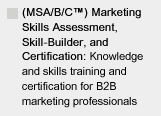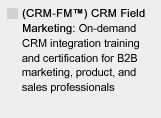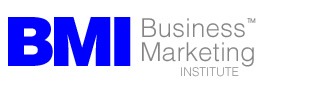MAKE SURE YOU CONTINUE TO RECEIVE EACH ISSUE OF TUESDAY MARKETING NOTES—CLICK HERE TO RENEW YOUR FREE SUBSCRIPTION (IF YOU'VE ALREADY SUBSCRIBED, NO NEED TO RE-SUBSCRIBE)
 Up Close and Persona is a complimentary, interactive tool designed using the methodology of B2B marketing strategist Ardath Albee to help marketers create buyer personas. Buyer Personas are a critical tool that helps arm marketers with what they need to know to create content so relevant that buyers can't help but take the next step toward purchase. Check it out today!
Up Close and Persona is a complimentary, interactive tool designed using the methodology of B2B marketing strategist Ardath Albee to help marketers create buyer personas. Buyer Personas are a critical tool that helps arm marketers with what they need to know to create content so relevant that buyers can't help but take the next step toward purchase. Check it out today!
Why BANT is Bunk for Today's B2B Buyer
by Ardath Albee, CEO, Marketing Interactions
In my work with B2B companies, I spend a lot of time on the phone with salespeople while doing research for the creation of buyer personas and the development of content strategies that dovetail with sales objectives. One of the questions I always ask is for the salesperson to define what they consider to be a qualified lead.
What I still mostly hear is the definition of BANT:
• Budget
• Authority
• Need
• Timing
And salespeople are adamant about these criteria. Most likely willing to wrestle for them :)
Yet, when I interview buyers and customers about their buying process, some of those criteria are found to be, well, bunk. BS. Irrelevant.
Salespeople need to start thinking differently. Unless they do so, BANT will be one of the reasons why the leads marketing passes to them will continue to be considered low quality. This is because today's markets are dynamic. Buyers have changed, but BANT hasn't. So some of the BANT criteria for your hottest leads will likely be missing. Thinking this means the leads aren't qualified could be a big mistake.
Let's take a look at why BANT needs a bit of renovation.
Budget
Unless you sell something that is a line item for your customers, it's highly likely that budget may not exist until after the business case has been built. Why? Because when the budget was developed 8 or 9 months ago, they hadn't recognized the need to solve the problem—or even that the problem existed. But it can also point to a larger problem that needs to be solved that may be pulling funding from across lines of business, so it's not evident where the money is coming from.
In fact, 48% of buyers surveyed by DemandGen Report say their purchase of a complex B2B product/solution was initially unbudgeted. According to the report, "[the purchases] were deemed necessary after looking at the solution's impact on other adopters and building an internal business case for the solution." Only 11% said so in 2011, showing just how much the budgeting process is shifting.
When you consider that another 14% say the budget was determined after soliciting multiple bids, that means 62% of purchases were made without an initial budget in place.
Budget is no longer a static criterion that sellers can expect to see in place. This makes it a bit moot as a qualifier. Perhaps it would be better to evaluate the company or account to determine if they could buy from you if they decide it's a worthwhile choice. Company characteristics might be better drivers than budget. Then again, that puts the onus on your company to do the heavy lifting to make it so.
Authority
This is one that makes me grit my teeth. Salespeople all want to speak to the person that signs on the dotted line. (We need a CIO persona is something I hear a lot) But, guess what? That person isn't usually the one building a relationship with your company or reading your content, attending your webinars or sharing your infographics. Nearly all the executives I speak with who have signing authority are too busy to do their own research or talk to vendors until the short list is formed.They put that responsibility onto their staff. And I'd suggest you make friends.
Depending on which research you believe, there are 7 to 21 people involved in a complex buying decision. Maybe only 1 of those people can sign off, but if a bunch of them say "NO" then you're out. Instead, it would behoove you to understand the hierarchy of the buying committee and what each of them cares most about. (Personas) Choose wisely based on influence level.
In my opinion, authority is also a rather dynamic term these days. Considering that most of the people I interview say they turn first to colleagues and peers for referrals, their authority shouldn't be under estimated, either. In fact, think cultivation; it's much more productive.
Only 9% of the 170 B2B buyers who responded to the DemandGen Report survey represented themselves as buyers who allocated or approved budgets. Most of the rest regarded themselves as influencers and recommenders. And 50% of overall responders say they're inviting more internal members to the input party.
Need
This one is probably the most valid of the BANT criteria for without it there's no possiblity of making a sale. But think carefully about how you define this; is it a need or really a want? How important is the problem that's being solved in the scheme of things? For the buyer? In relation to company objectives?
I agree with this criteria. It needs to be there. This being said, it's important to realize that it may not look like what you expect. Developing buying insights about how the different members of the buying committee view the issues they're trying to resolve is critical to aligning conversations that are relevant - as well as for lead qualification.
For example, I just did a round of interviews where the customers were almost always switching from one vendor to another. The problem being resolved? Responsiveness and a consultative approach by the vendor they selected to help them improve related processes and workflows. Their current vendor's solution was fine, it was their attitude that needed adjusting. There's a different approach to this issue than the one you might have thought of originally when trying to prove your solution was a worthwhile investment. What if it's not about that?
Timing
Salespeople are driven by urgency. They need to close deals in short windows. One salesperson told me recently that without an established deadline, he wasn't interested. Yikes. I get it—really I do. Salespeople have quotas to meet at the end of the month. But, given the way the other criteria have changed, there needs to be a plan. I've seen deals that were projected to close in 30 days drag on for months and deals projected at 6 months out close in 30 days.
Business needs evolve quickly. There can be a long period of feet dragging, but once everything clicks into place, then things can happen pretty fast. The issue here is who's going to get everything to click into place? If not you, then it will be a competitor that sees what could be hidden potential.
Do you know where the value levers are for each member of the buying committee? How can you pull them in a way that gets each of them to convince the others? Rather than relying on the prospect for the urgency, perhaps that's something we should be bringing to the table.
No—not with desperate attempts to close a prospect that's not ready, but by showing them the value of the impact they're unable to have today—without our solution.
The Need for Dynamic Criteria
So, if not BANT, then what?
The main difference between what worked in the past and what works now is how dynamic the business environment has become. Speed of change is crazy. We need qualified lead criteria that can continually shift in response to changing buyer situations and behavior patterns. I don't have all the answers, but here are a few ways to look at some criteria I'm seeing have more impact in lead quality definition in today's markets.
• Need stays—but I'd work on defining which types of need are a sweet spot for your customers. All needs are not pivot points for success. And one need doesn't look the same across the stakeholder group, depending on roles and responsibilities of who interacts with your company. How might "need" be defined better? Has something changed recently that reframes a need you fulfill?
• Connections—if the prospect you have access to isn't the one who can make the decision, does he/she have a direct connection to who can? How many contacts from the prospective company are in your database? What type of organizational hierarchy are they dealing with? Which one has the perspective that will allow for the most urgency to be recognized based on value add?
• Company—how closely does the company resemble your best customers? In other words, even if the contact you have is interactive, interested and highly engaged, if the company isn't a good fit and won't likely buy from you then you're wasting your time, no matter how great the lead score. Additionally, if you don't have other customers in the prospect's industry, can you prove your solution will be relevant for them? Based on what? How will you convince them that your expertise will continue to pay off after the purchase is completed?
What do you think? What would you add to this list?
Ardath Albee (Ardath@marketinginteractions.com) is a B2B Marketing Strategist and the CEO of her firm, Marketing Interactions, Inc. She helps B2B companies with complex sales create eMarketing strategies that use contagious content to turn prospects into buyers. Ardath was recently selected as one of the Top 20 Women to Watch in Sales Lead Management. Among her clients are Cisco, Tyco Electronics, Adobe, BMC Software, funeralOne and Sykes, Inc. Ardath is the author of eMarketing Strategies for the Complex Sale (McGraw-Hill). Read her blog and follow her on Twitter at @ardath421.








